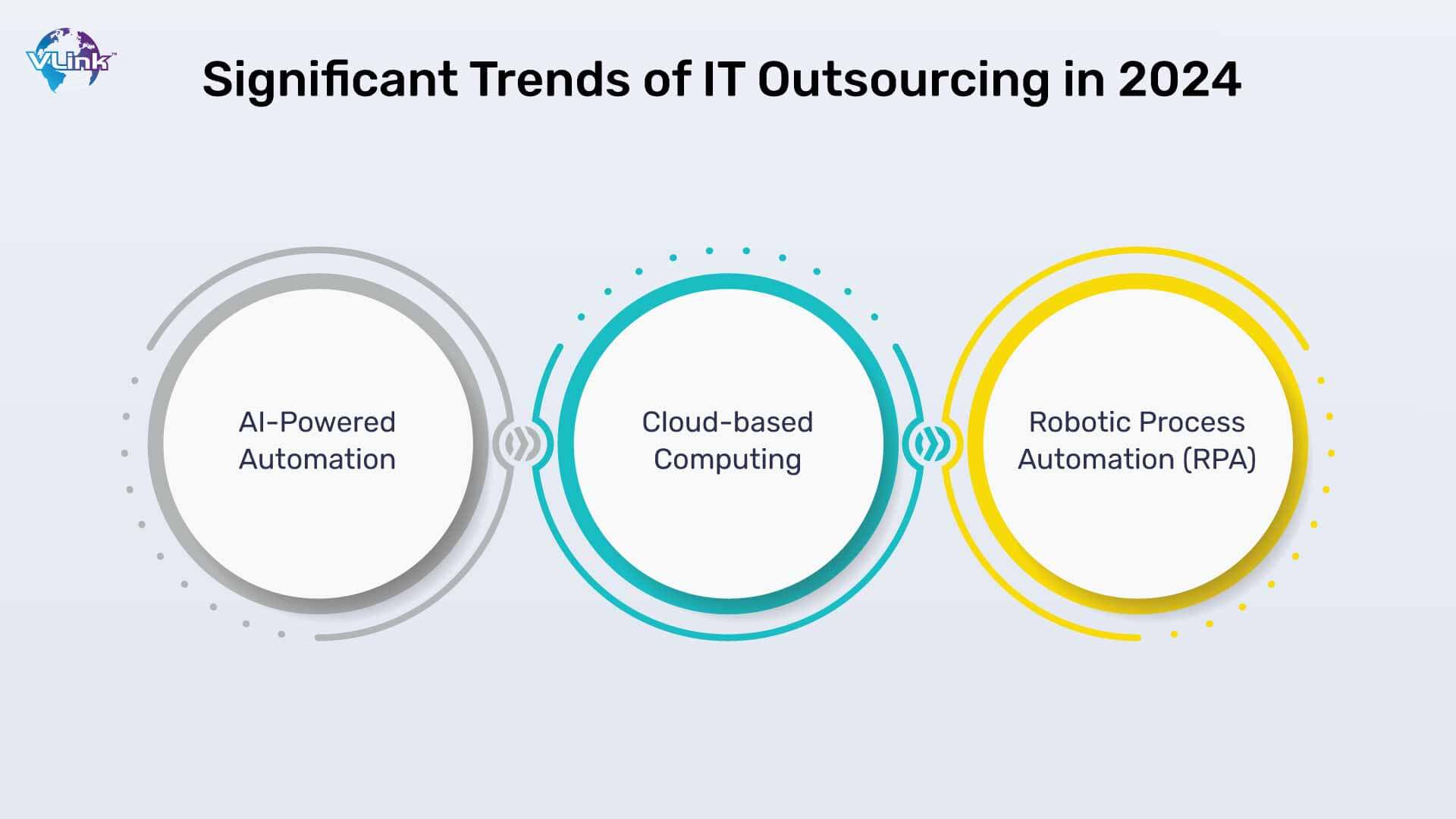Once a trend, and now a reality, in the era of digitalization, IT outsourcing has become a feasible choice for worldwide businesses.
The reason for this transition is that outsourcing in software development has made even drastic reduction in costs possible.
Additionally, undoubtedly, it is a critical factor of innovation and growth. Needless to say, outsourcing has opened the doors to global talent, flexibility, and the ability to innovate.
By now, the subject of the growth of IT outsourcing trends has been worth exploring. Indeed, in order for startups—especially “the tech life” ones, to have successful lives in this new era, it’s critical to grasp these IT outsourcing trends quickly.
Therefore, let us not waste any more time and get into the blog to understand everything about it- definition, importance, trends, and, of course, the future of IT outsourcing.
What is IT Outsourcing?
It is the practice of launching specific IT functions or services externally to vendors or third-party service providers.
Companies turn to IT outsourcing to simplify operations, decrease costs and gain access to specialized expertise without needing to supplicate their in-house team members.
Among the most popular IT services outsourced to third-party vendors are software development, network management, technical support, and infrastructure maintenance.
Outsourcing IT tasks allow businesses to concentrate on their primary expertise areas and take advantage of their partners’ scalability, flexibility, and efficiency.
This approach is a critical factor to keeping up with the competition in an increasingly rapidly developing technology-driven environment.
Importance of IT Outsourcing
IT outsourcing becomes a crucial part of any business operations in today’s dynamic times.
There are many advantages and benefits, which make this function crucial for business. Among them are the opportunity to get specialized skills, which are not feasible for an organization to develop in-house. This point significantly improves effectiveness and productivity.
Additionally, organizations save money on infrastructure maintenance, allowing them to allocate these resources more tactically.
Plus, outsourcing also means scalability, allowing businesses to adjust to market changes and technological evolution in a matter of weeks.
In simpler words, IT outsourcing helps a business to concentrate on its cores and develop external mechanisms to stimulate innovation and expansion and leave all the competitors behind.
Significant Trends of IT Outsourcing in 2024

There are certainly many but let’s talk about the top IT sourcing trends in 2024:
AI-Powered Automation:
AI-powered automation is revolutionizing the way businesses and third-party providers think about the concept of outsourcing. Firstly, many of the tedious, repetitive tasks that were once delegated can now be performed by AI technology, i.e. Artificial Intelligence.
Here are three nuanced impacts that AI are having:
- AI-powered chatbots and virtual assistants make the live agent’s customer support better. They offer specialized care while answering questions and providing information and solving basic problems. Moreover, with the requisite proportion of the human feeling touch, AI-powered chatbots and virtual assistants can significantly enhance customer satisfaction as well as engagement.
- The increased application of AI-driven language translation tool supports global collaboration in outsourcing. The language barrier has always been one of the challenges in the whole outsourcing industry, after all. However, the use of AI-driven language translation has made it easier to communicate and collaborate within global teams.
- Finally, AI promotes innovation in the outsourcing market, providing new service types and business models creation. AI also allows predicting market, customer trends, and operations vulnerabilities. This serves as an opportunity to anticipate outcomes and, thus, to evaluate and optimize resources best-use paths.
Cloud-based Computing
Cloud-based computing has revolutionized outsourcing, specifically in the IT industry. It makes outsourcing IT management, data storage, and software development much more accessible. Wondering how?
Have a look:
- Global Accessibility and Collaboration:
Teams all around the globe can download files, share papers, and access tools and resources in real time. Therefore, in-house and outsourcing staff members can sustain constant communications and cooperation.
- Scalability and Flexibility:
Unlike some traditional solutions, cloud services can be scaled to meet your business needs. You can grow and shrink your cloud services where necessary without investing in expensive infrastructure changes.
- Innovation Acceleration:
Cloud-based platforms frequently include modern technology areas such as AI, machine learning, and analytics. Outsourcing partners can utilize these tools to push the innovation envelope, allowing for greater, more sophisticated solutions for their clients.
- Business Continuity and Disaster Recovery:
No one wants to imagine the worst-case situations that might happen. However, cloud-based computing allows for dependable backup and disaster recovery. Therefore, enterprise continuity and exceptional resilience in the unlikely event are guaranteed.
Robotic Process Automation (RPA)
Robotic process automation essentially enables businesses to create and use software bots that imitate human behavior.
The software bots understand what is present on a screen, type fresh information, assess data, and do several additional things.
To sum up, RPAs boost operational efficiency and save companies money.
Here are several additional examples of how RPAs are revolutionizing the outsourcing business.
- Improving Accuracy and Compliance:
RPA systems adhere to rules without question, reducing the likelihood of human mistakes. This is especially important in industries with strict regulatory requirements, for which RPA can help meet compliance requirements and quality standards.
- Faster Turnaround Times:
Automated processes result in quicker processing of outsourced processes. RPA can be up and running 24 hours a day, seven days a week, resulting in a quicker turnaround time for any service.
- Ever-Increasing Cognitive Capabilities:
Machine learning and natural language processing are two cognitive technologies that are used to create an Advanced RPA solution. Bots are also becoming more experienced and capable of more sophisticated activities or processes that involve judgment competencies and working with unstructured data.
Impact of Remote Work on IT Outsourcing Trends
Outsourcing has long worked with teams who are not physically present. That once felt extremely foreign to the average 9-5 businessperson. Not anymore; because of remote work, that model seems normal now. So, how are traditional outsourcing models changing to fit current remote work habits?
More and more businesses use hybrid models and combine on-site and remote resources.
It is more flexible and enables the natural equilibrium between internal and external domains. Moreover, remote work has almost doubled the available talent pool and made teams more diverse. Above all, finding the best professional has never been easier for companies.
Regardless of physical location, they can bring specialized skills and expertise. Additionally, they consist of various people from different regions, cultures, and backgrounds who can create a more inclusive and diverse working environment.
Due to these factors, remote work resulted in a trend toward client-centric models of outsourcing. The renewed partnership dynamic allows clients to demand transparency, real-time collaboration, and joint decision-making.
Moreover, to this point, because of the remote work paradigm, the focus on workers’ well-being and mental health has grown as well. It implies that the companies are more willing to cover the mental health of their remote and outsourced team to ensure productivity in the long term.
Future Challenges and How to Tackle Them?
The serious threat of cyberattacks and data breaches should also be mentioned while discussing the outsourcing trends. Just in the last year, 2023, the average data breach cost $4.45 million for businesses worldwide.
The future indicates that businesses’ dependence on digital platforms will increase further. Therefore, both businesses and companies they outsource to need to invest in cybersecurity to ensure data safety and trust.
10 Ways to Protect Your Business from Cyberattacks While Outsourcing in 2024
Here are ten ways you can protect your business from every type of cyberattacks in the time ahead:
- Ensure comprehensive due diligence before selecting an outsourcing partner. For example, verify the partner’s policy and practice in security and compliance with applicable regulations. It is also vital to evaluate the outsourcing partner’s history in data security and the amount of experience in handling sensitive data.
- Ensure that security requirements are properly defined in outsourcing contracts. Contracts should develop detailed clauses on data protection, confidentiality, and compliance. It should also have guidelines on the security framework that needs to be implemented and how breaches shall be dealt with.
- Ensure that encryption protocols are incorporated into data in transit and data at rest. Encryption of data provides an additional layer of protection to data shared online. It becomes hard for any third party to access or manipulate the information without authorization.
- Implement strong access controls and authentication measures. Make sure that only authorized individuals can obtain access to sensitive data and apply multi-factor authentication to increase security.
- Regularly conduct security audits and evaluations of the provider’s systems— complete penetration testing, vulnerability testing, and security evaluations to detect and fix vulnerabilities in the architecture.
- Enforce thorough security training for the internal staff and the outsourcing partner’s employees. Everyone must be aware of all the security measures, the significance of data protection, and potential impacts of a breach.
- This procedure should be followed by continuous tracking of the network activity and creation of the relevant response plan. When one has real-time monitoring on the network, it is possible to notice any irregular or potential breach. Thus, you can address the issue immediately to prevent exposure.
- Ensure that the parties understand and comply with the data protection laws and regulations involved in the outsourcing. It is essential to set clear data residency requirements and outline which safety law and regulatory standards the outsourcing partner must follow.
- Encourage open communication about security processes. Develop a shared approach to combat security issues and promote best practices to keep the surrounding environment safe.
- Finally, cybersecurity insurance can reduce financial risk if one has a data breach of sensitive information. Cybersecurity insurance will pay for investigation costs into a data breach, remediation response, and compliance with legal requirements post-breach.
How to Find the Best Outsourcing Partner in 2024?
As we look to the future of outsourcing industry, we can be sure that:
- The above trends are going to continue shaping what and how businesses outsource.
- Businesses will prioritize long-term relationships with nearshore providers.
- Remote work will phase out the reliance on outsourcing and diminish the geographical attributes of global team members.
- Cybersecurity will become a vital ongoing investment.
- The benefits of outsourcing are shifting to competitive advantage and creative solutions.
Being ahead of the game regarding the current trends is more important than ever before you can easily find the right outsourcing partner.
That’s why you should choose us, VLink.
VLink has an established reputation as a trusted outsourcing partner for 18+ years.
We work with companies of all types and sizes, offering the best IT outsourcing services in the market today.
Our numbers are impressive! So, don’t hesitate to reach out to our team to ensure the success of your business by outsourcing some of your crucial operations.
Frequently Asked Questions
IT outsourcing, in simpler words, is getting third-party vendors to supply IT-backed infrastructure solutions, software, and business procedures to enable corporate objectives. This approach usually includes cloud-enabled sourcing, software as a service, and utility services.
Outsourcing is a good business strategy for businesses that focuses on having a competitive edge in searching low-cost labor. This enables them to increase profits and pass lower costs on to consumers.
There are many but the most common outsourced tasks are IT management, administrative services, customer services and phone support, bookkeeping and accounting, and human resources.














